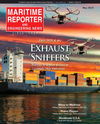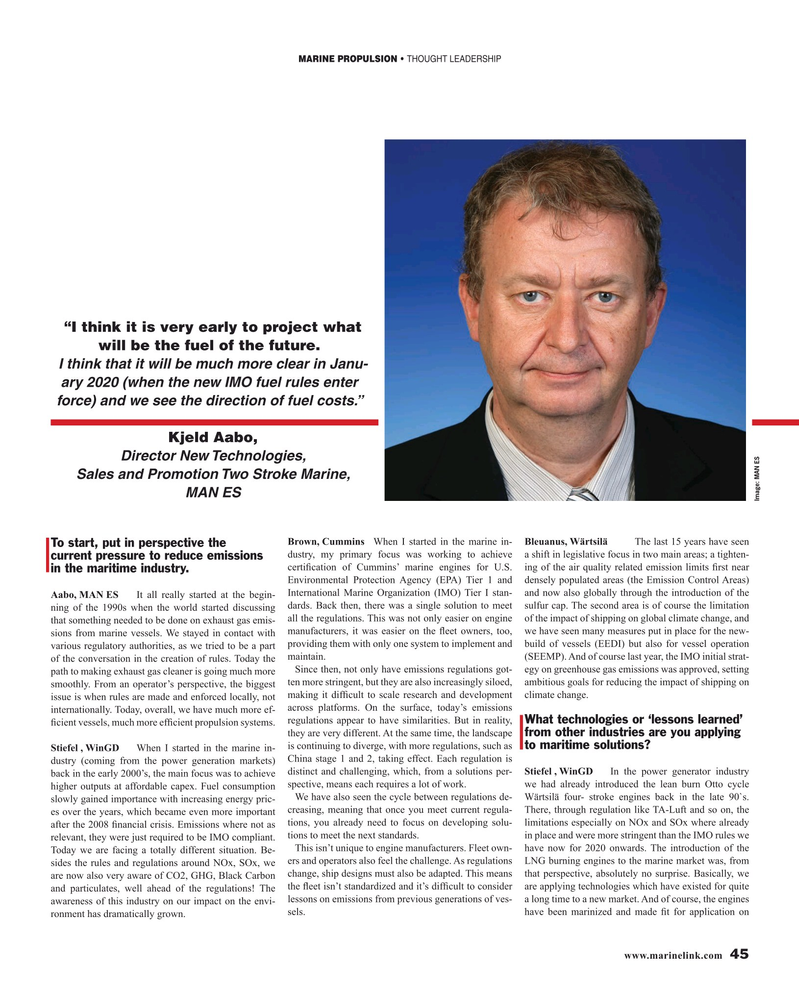
Page 45: of Maritime Reporter Magazine (May 2019)
Propulsion Annual - Green Marine Tech
Read this page in Pdf, Flash or Html5 edition of May 2019 Maritime Reporter Magazine
MARINE PROPULSION • THOUGHT LEADERSHIP “I think it is very early to project what will be the fuel of the future.
I think that it will be much more clear in Janu- ary 2020 (when the new IMO fuel rules enter force) and we see the direction of fuel costs.”
Kjeld Aabo,
Director New Technologies,
Sales and Promotion Two Stroke Marine,
MAN ES
Image: MAN ES
Brown, Cummins When I started in the marine in- Bleuanus, Wärtsilä The last 15 years have seen
To start, put in perspective the dustry, my primary focus was working to achieve a shift in legislative focus in two main areas; a tighten- current pressure to reduce emissions certi? cation of Cummins’ marine engines for U.S. ing of the air quality related emission limits ? rst near in the maritime industry.
Environmental Protection Agency (EPA) Tier 1 and densely populated areas (the Emission Control Areas)
International Marine Organization (IMO) Tier I stan- and now also globally through the introduction of the
Aabo, MAN ES It all really started at the begin- ning of the 1990s when the world started discussing dards. Back then, there was a single solution to meet sulfur cap. The second area is of course the limitation all the regulations. This was not only easier on engine of the impact of shipping on global climate change, and that something needed to be done on exhaust gas emis- sions from marine vessels. We stayed in contact with manufacturers, it was easier on the ? eet owners, too, we have seen many measures put in place for the new- various regulatory authorities, as we tried to be a part providing them with only one system to implement and build of vessels (EEDI) but also for vessel operation of the conversation in the creation of rules. Today the maintain. (SEEMP). And of course last year, the IMO initial strat-
Since then, not only have emissions regulations got- egy on greenhouse gas emissions was approved, setting path to making exhaust gas cleaner is going much more smoothly. From an operator’s perspective, the biggest ten more stringent, but they are also increasingly siloed, ambitious goals for reducing the impact of shipping on issue is when rules are made and enforced locally, not making it dif? cult to scale research and development climate change.
across platforms. On the surface, today’s emissions internationally. Today, overall, we have much more ef-
What technologies or ‘lessons learned’ regulations appear to have similarities. But in reality, ? cient vessels, much more ef? cient propulsion systems.
from other industries are you applying they are very different. At the same time, the landscape to maritime solutions? is continuing to diverge, with more regulations, such as
Stiefel , WinGD When I started in the marine in- dustry (coming from the power generation markets) China stage 1 and 2, taking effect. Each regulation is back in the early 2000’s, the main focus was to achieve distinct and challenging, which, from a solutions per- Stiefel , WinGD In the power generator industry higher outputs at affordable capex. Fuel consumption spective, means each requires a lot of work. we had already introduced the lean burn Otto cycle
We have also seen the cycle between regulations de- Wärtsilä four- stroke engines back in the late 90`s. slowly gained importance with increasing energy pric- es over the years, which became even more important creasing, meaning that once you meet current regula- There, through regulation like TA-Luft and so on, the after the 2008 ? nancial crisis. Emissions where not as tions, you already need to focus on developing solu- limitations especially on NOx and SOx where already relevant, they were just required to be IMO compliant. tions to meet the next standards. in place and were more stringent than the IMO rules we
This isn’t unique to engine manufacturers. Fleet own- have now for 2020 onwards. The introduction of the
Today we are facing a totally different situation. Be- sides the rules and regulations around NOx, SOx, we ers and operators also feel the challenge. As regulations LNG burning engines to the marine market was, from are now also very aware of CO2, GHG, Black Carbon change, ship designs must also be adapted. This means that perspective, absolutely no surprise. Basically, we and particulates, well ahead of the regulations! The the ? eet isn’t standardized and it’s dif? cult to consider are applying technologies which have existed for quite lessons on emissions from previous generations of ves- a long time to a new market. And of course, the engines awareness of this industry on our impact on the envi- sels. have been marinized and made ? t for application on ronment has dramatically grown. www.marinelink.com 45
MR #5 (42-49).indd 45 5/3/2019 1:44:10 PM

 44
44

 46
46
